The belted kingfisher (Megaceryle alcyon) is a captivating avian species found across North America. While they are known for their impressive fishing skills and distinct calls, there is another intriguing aspect to their biology: the differences between males and females.
In this article, we explore the contrasting features of belted kingfisher males and females. From variations in plumage coloration to differences in size, understanding the disparities between the two genders provides valuable insights into their reproductive strategies and evolutionary adaptations.
By delving into the male versus female dynamics of belted kingfishers, we gain a deeper appreciation for the fascinating intricacies of their biology and the role sexual dimorphism plays in their lives.
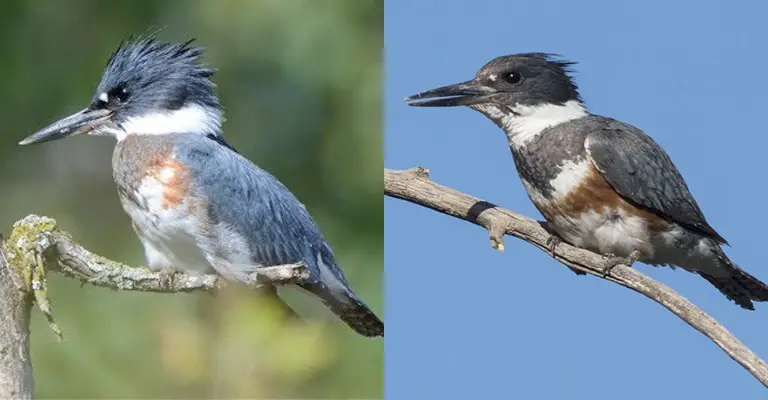
The Adult Male Belted Kingfisher
The adult male Belted Kingfisher showcases an exquisite bluish-gray coloration on its upper body. This plumage gives the bird a sleek and elegant appearance as it perches or dives with incredible precision.
The muted tones of blue and gray create a visually appealing contrast, making the male Belted Kingfisher a sight to behold.
Characteristics of the White Underbody and Bluish Gray Breast Stripe
Complementing the bluish-gray upper body, the male Belted Kingfisher boasts a clean white underbody. This stark contrast between the upper and underparts creates a striking visual effect, making it easier to spot the bird even from a distance.
Additionally, a prominent bluish-gray breast stripe adorns the bird’s chest, adding further distinction to its plumage.
The Large Head With a Bushy Crest
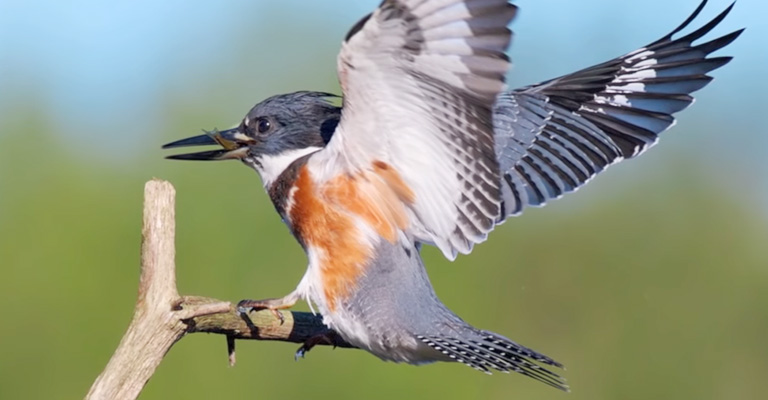
One of the most notable features of the adult male Belted Kingfisher is its large head, which appears to be out of proportion with its body. This unique attribute adds to the bird’s charismatic appeal, making it instantly recognizable.
The head is adorned with a bushy crest, giving the male Belted Kingfisher a regal and majestic appearance.
Highlighting the Spear-shaped Bill
The male Belted Kingfisher possesses a remarkable bill that is shaped like a spear. This elongated, pointed bill is a specialized tool for the bird’s hunting behavior, allowing it to swiftly dive into the water to catch fish.
The bill’s sharp and streamlined structure is a testament to the bird’s exceptional hunting skills and adaptability to its aquatic environment.
Emphasizing the Absence of a Rusty Belt Across the Belly
One distinctive feature that sets the adult male Belted Kingfisher apart from its female counterpart is the absence of a rusty belt across its belly.
Unlike the female, whose plumage exhibits a second rust-colored band on the belly, the male maintains a consistent bluish-gray and white coloration throughout its underparts.
This distinction serves as a key identifier when differentiating between male and female Belted Kingfishers.
The Adult Female Belted Kingfisher
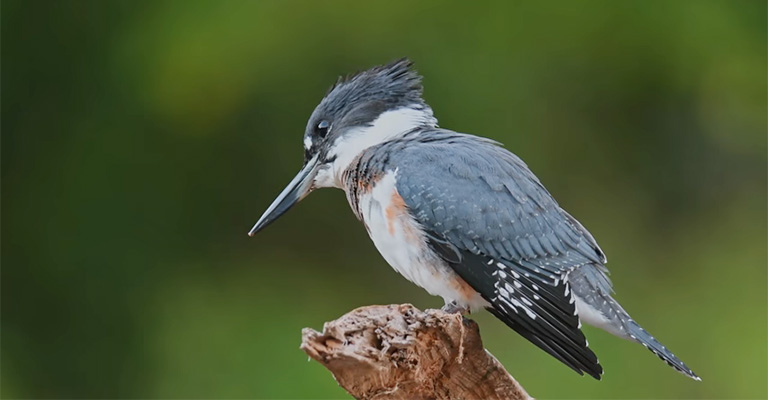
In terms of overall plumage, the adult female Belted Kingfisher shares several similarities with its male counterpart. She also showcases the beautiful bluish-gray coloration on her upper body, echoing the elegance of the male’s appearance.
The white underbody and bluish-gray breast stripe are also present in the female, giving her a comparable regal presence.
Identification of the Additional Rusty Belt Across the Belly
What sets the adult female Belted Kingfisher apart from the male is the presence of an additional distinguishing feature—a rusty belt across her belly.
This rust-colored band provides a stark contrast to the rest of her plumage and serves as a key identifier for female identification. The rusty belt adds a touch of warmth and character to the female’s overall appearance.
Contrasting Features Between the Male and Female Plumage
While the male and female Belted Kingfishers share many visual characteristics, there are notable differences in their plumage. The absence of the rusty belt in the male is a prominent distinction, as well as the exclusive presence of this feature in the female.
These contrasting features contribute to the overall diversity and beauty of the Belted Kingfisher species.
Significance of the Rusty Belt for Female Identification
The rusty belt across the belly of the adult female Belted Kingfisher holds great significance for identification purposes. It acts as a reliable visual cue to differentiate between male and female individuals in the species.
Birdwatchers and enthusiasts can use this unique feature to accurately identify and appreciate the presence of female Belted Kingfishers in their natural habitats.
The adult female Belted Kingfisher showcases a captivating blend of similarities and distinct features compared to the male. While sharing similarities in plumage, she stands out with the addition of a beautiful rusty belt across her belly.
This unique feature plays a crucial role in identifying and appreciating the diversity within the Belted Kingfisher population, adding a touch of rustic elegance to the female’s already enchanting appearance.
Juvenile Belted Kingfishers
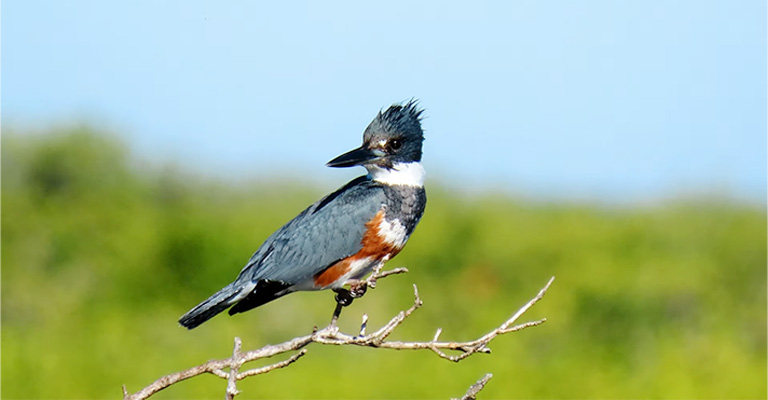
Juvenile Belted Kingfishers display noticeable differences in their plumage compared to adults. Their feathers appear less defined and lack the crisp, vibrant colors seen in mature birds.
These differences contribute to the overall mottled appearance of juveniles, hinting at their developmental stage.
The Mottled Appearance of Juveniles
The mottled appearance of juvenile Belted Kingfishers is characterized by a mix of colors and patterns. Their feathers may display a blend of various shades, including grays, browns, and muted blues.
This mottled pattern helps juveniles blend into their surroundings and provides them with camouflage and protection during their early stages of life.
Variation in the Coloration of the Breast Band
One notable feature of juvenile Belted Kingfishers is the variation in the coloration of their breast band. Unlike the uniform breast band seen in adults, the breast band of juveniles can exhibit a range of colors.
It may appear as a mixture of rusty brown and bluish-gray, gradually transitioning into a more defined and consistent coloration as the bird matures.
Transition From Juvenile to Adult Plumage
As juvenile Belted Kingfishers grow and develop, they undergo a remarkable transformation in their plumage. Over time, their mottled appearance gives way to the more distinct and vibrant colors of the adult plumage.
The transition from juvenile to adult plumage involves the gradual acquisition of the characteristic bluish-gray upper body, white underbody, and definitive breast band specific to their gender.
Juvenile Belted Kingfishers exhibit distinct characteristics that differentiate them from adult individuals. Their mottled appearance, varying coloration of the breast band, and less defined plumage mark their developmental stage.
As they mature, these juvenile birds undergo a gradual transition, transforming into elegant and recognizable adults with their vibrant colors and distinctive plumage patterns.
Observing this journey of transformation provides a unique perspective on the life cycle and growth of Belted Kingfishers.
Tips for Identifying Belted Kingfishers’ Gender in the Field
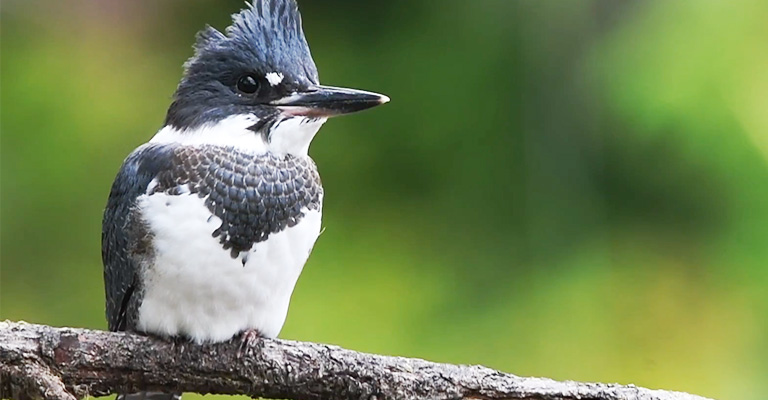
Spotting Belted Kingfishers can be a thrilling endeavor. To increase your chances of sighting these birds, focus on their preferred habitats, such as rivers, lakes, and other bodies of water.
Look for perches like branches or utility wires near the water’s edge, where they can survey their hunting grounds. Listen for their distinctive rattling call, which can help guide you to their location.
Techniques for Distinguishing Between Males and Females
Differentiating between male and female Belted Kingfishers requires attention to specific plumage characteristics. Look for the absence or presence of a rusty belt across the belly—a defining feature of female identification.
Note the overall coloration and the presence of a bluish-gray breast stripe, which both males and females possess. Comparing the size of the head and crest can also provide subtle clues, as males typically have larger heads and more pronounced crests.
Notable Behaviors to Aid in Identification
In addition to visual cues, observing the behaviors of Belted Kingfishers can assist in identification. Note their distinctive flight pattern, characterized by rapid wingbeats and occasional hovering.
Watch for their remarkable fishing dives, where they plunge headfirst into the water to catch prey. Males may exhibit territorial behaviors, including vocalizations and displays, which can further aid in distinguishing them from females.
Resources for Further Assistance in Bird Identification
For those seeking additional support in bird identification, several resources are available. Field guides specific to birds of your region can provide detailed information and visual references.
Online platforms and mobile applications dedicated to birding, such as eBird and Merlin Bird ID, offer species-specific profiles, images, and even vocalizations to assist in accurate identification.
Local birding communities and organizations can also provide valuable insights and guidance for Belted Kingfisher identification.
Observing and identifying Belted Kingfishers in the field requires a combination of attentive observation, knowledge of plumage characteristics, and understanding of their behaviors.
Belted Kingfisher Plumage Characteristics
| Plumage Characteristic | Adult Male | Adult Female | Juvenile |
| Upper Body Color | Bluish gray | Bluish gray | A mottled mix of colors |
| Underbody Color | White | White | A mottled mix of colors |
| Breast Stripe | Bluish gray | Bluish gray | A mottled mix of colors |
| Crest | Bushy | Bushy | Bushy |
| Bill Shape | Spear-shaped | Spear-shaped | Spear-shaped |
| Belly Belt | Absent | Rusty-colored | Absent |
| Notable Behavior | Rapid wingbeats, diving | Rapid wingbeats, diving | N/A |
FAQs
Yes, Belted Kingfishers can be found in various aquatic habitats, including both freshwater and saltwater environments. They are commonly seen along rivers, lakes, ponds, marshes, coastal areas, and even estuaries.
Juvenile Belted Kingfishers can be identified by their overall mottled appearance, which includes a mix of grays, browns, and muted blues. Additionally, the breast band of juveniles may display a combination of rusty brown and bluish gray.
With time, as they mature, their plumage becomes more defined and takes on the distinctive features of adult individuals.
Yes, Belted Kingfishers are known to undertake seasonal migrations. In many parts of their range, they are considered partial migrants, with some individuals migrating to warmer regions during the winter months, while others remain in their breeding territories year-round.
Belted Kingfishers are skilled hunters that primarily feed on fish. They use a sit-and-wait hunting technique, perching on a high branch or utility wire near the water’s edge, and patiently scanning for prey.
When they spot a fish, they dive headfirst into the water, using their sharp beak to capture the prey. They can also feed on other aquatic animals like crayfish and amphibians.
Belted Kingfishers are generally solitary birds, and they are territorial during the breeding season. They prefer to maintain their own territories along water bodies and often chase away intruders.
However, they may tolerate the presence of their mate within their territory during the breeding season.
Conclusion
The belted kingfisher exhibits notable differences between males and females. While both genders share similar physical characteristics, such as the distinct crest and long, pointed bill, their appearances differ in terms of coloration.
Males showcase vibrant blue-gray feathers on their upper parts and a prominent blue band across their chest, while females sport a rufous-colored band instead. Additionally, males tend to be slightly larger in size than females.
These distinctions in plumage and size likely play a role in courtship and mate selection. I can now anticipate that you have understood the basic differences between male and female Belted kingfishers. Thank you for staying with us.